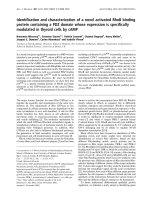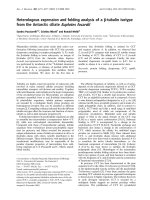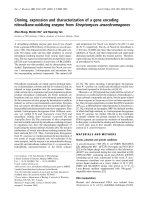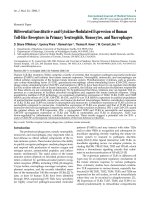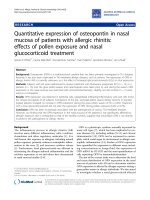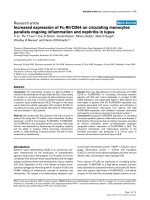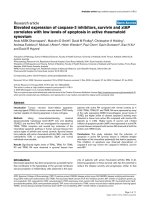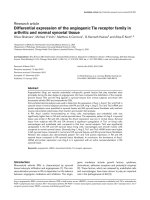Báo cáo y học: "MMP-3 expression and release by rheumatoid arthritis fibroblast-like synoviocytes induced with a bacterial ligand of integrin α5β" pdf
Bạn đang xem bản rút gọn của tài liệu. Xem và tải ngay bản đầy đủ của tài liệu tại đây (594.83 KB, 9 trang )
Open Access
Available online />R118
Vol 7 No 1
Research article
MMP-3 expression and release by rheumatoid arthritis
fibroblast-like synoviocytes induced with a bacterial ligand of
integrin α5β1
Mirjam B Zeisel
1
, Vanessa A Druet
1
, Dominique Wachsmann
1*
and Jean Sibilia
2*
1
Inserm 392, Infection et Inflammation, Université Louis Pasteur de Strasbourg, Faculté de Pharmacie, 74 route du Rhin, 67400 Illkirch, France
2
Département de Rhumatologie, Hôpitaux Universitaires de Strasbourg, Strasbourg, France
* Contributed equally
Corresponding author: Dominique Wachsmann,
Received: 26 Jun 2004 Revisions requested: 18 Aug 2004 Revisions received: 17 Sep 2004 Accepted: 12 Oct 2004 Published: 24 Nov 2004
Arthritis Res Ther 2005, 7:R118-R126 (DOI 10.1186/ar1462)
http://arthr itis-research.com/conte nt/7/1/R118
© 2004 Zeisel et al.; licensee BioMed Central Ltd.
This is an Open Access article distributed under the terms of the Creative Commons Attribution License ( />2.0), which permits unrestricted use, distribution, and reproduction in any medium, provided the original work is cited.
Abstract
Fibroblast-like synoviocytes (FLSs) play a major role in the
pathogenesis of rheumatoid arthritis (RA) by secreting effector
molecules that promote inflammation and joint destruction. How
these cells become and remain activated is still elusive. Both
genetic and environmental factors probably play a role in
transforming FLSs into inflammatory matrix-degrading cells. As
bacterial products have been detected in the joint and shown to
trigger joint inflammation, this study was undertaken to
investigate whether a bacterial ligand of integrin α5β1, protein I/
II, could contribute to the aggressive behavior of RA FLSs.
Protein I/II is a pathogen-associated molecular pattern (PAMP)
isolated from oral streptococci that have been identified in the
joints of RA patients. The response of RA and osteoarthritis
FLSs to protein I/II was analyzed using human cancer cDNA
expression arrays. RT-PCR and pro-MMP-3 (pro-matrix
metalloproteinase) assays were then performed to confirm the
up-regulation of gene expression. Protein I/II modulated about
6% of all profiled genes. Three of these, those encoding IL-6,
leukemia inhibitory factor, and MMP-3, showed a high
expression level in all RA FLSs tested, whereas the expression
of genes encoding other members of the cytokine or MMP-
family was not affected. Furthermore, the up-regulation of MMP-
3 gene expression was followed by an increase of pro-MMP-3
release. The expression of interferon regulatory factor 1 and
fibroblast growth factor-5 was also up-regulated, although the
expression levels were lower. Only one gene, that for insulin-like
growth factor binding protein-4, was down-regulated in all RA
FLSs. In contrast, in osteoarthritis FLSs only one gene, that for
IL-6, was modulated. These results suggest that a bacterial
ligand of integrin α5β1 may contribute to the aggressive
behavior of RA FLSs by inducing the release of pro-inflammatory
cytokines and a cartilage-degrading enzyme, such as IL-6 and
MMP-3, respectively.
Keywords: fibroblast-like synoviocytes, integrin α5β1, MMP-3, PAMP
Introduction
Fibroblast-like synoviocytes (FLSs) appear to play a major
role in the pathogenesis of rheumatoid arthritis (RA). These
cells are characterized by pannus formation, cartilage inva-
sion, and secretion of effector molecules, including
cytokines and chemokines, that act on various cells to pro-
mote inflammation [1-3]. Recent experiments have shown
that although FLSs were able to secrete large amounts of
IL-6 and IL-8, they failed to release significant amounts of
TNF-α, IL-1, IL-15, and IL-18 [4,5]. They showed a dissoci-
ated pattern of cytokine mRNA and protein expression,
suggesting the existence of post-transcriptional regulation.
FLSs are also the principal promoters of joint destruction
[3], either through the release of proteolytic enzymes such
as matrix metalloproteinases (MMPs), or indirectly through
the stimulation of osteoclastogenesis. FLSs are the source
of a broad range of MMPs, including MMP-1, MMP-13, and
MMP-3; the last of these degrades different types of
ELISA = enzyme-linked immunosorbent assay; FACS = fluorescence-activated cell sorter; FCS = fetal calf serum; FGF = fibroblast growth factor;
FLS = fibroblast-like synoviocyte; GAPDH = glyceraldehyde-3-phosphate dehydrogenase; IL = interleukin; IRF = interferon regulatory factor; LPS =
lipopolysaccharide; MMP = matrix metalloproteinase; OA = osteoarthritis; PAMP = pathogen-associated molecular pattern; PCR = polymerase chain
reaction; PRR = pattern-recognition receptor; RA = rheumatoid arthritis; RT = reverse transcriptase; SSC = standard saline citrate; TLR = Toll-like
receptor.
Arthritis Research & Therapy Vol 7 No 1 Zeisel et al.
R119
collagen and proteoglycans and activates other MMPs
such as MMP-2 and MMP-9.
How these cells become and remain activated is still not
known. Numerous factors may account for the permanent
changes observed in FLS functions. To date it is very diffi-
cult to define whether FLSs are changed in response to
genetic modifications, such as mutations or microsatellite
instability, or in response to environmental factors. Both
factors probably play a role in transforming FLSs into invad-
ing, inflammatory, matrix-degrading cells. Exposure to an
inflammatory environment may even result in DNA damage
[6]. On the other hand, genetic modifications may contrib-
ute to inflammation: it has been shown that a decrease of
the expression of p21, an inhibitor of the cyclin-dependent
kinases which is regulated by p53, activates activating pro-
tein-1, leading to enhanced cytokine and MMP synthesis in
RA FLSs [7,8].
Regarding environmental factors, there has been consider-
able interest in a possible role of innate immunity in the ini-
tiation and perpetuation of inflammation during RA.
Bacterial products – also called pathogen-associated
molecular patterns (PAMPs) – such as lipopolysaccharide
(LPS), peptidoglycan, and bacterial DNA have been
detected in the joint [9,10] and were shown to trigger joint
inflammation: in fact, oral administration of LPS exacer-
bates collagen-induced arthritis in mice, and intra-articular
injection of CpG oligonucleotides and of peptidoglycan
leads to transient arthritis in mice [11-13]. As DNA and
rRNA from a wide variety of bacterial species have been
identified in the joints of RA patients [9,14,15], it has been
suggested that joint inflammation could be triggered by
PAMPs common to various microorganisms interacting
with cellular pattern-recognition receptors (PRRs). FLSs
express a large number of PRRs, such as Toll-like receptor
(TLR)-2, TLR-4, and TLR-9 [16], as well as numerous
integrins. Their interaction with a variety of PAMPs may
contribute to the aggressive phenotype of RA FLSs.
We reported previously that interaction of protein I/II, a cell
wall component of oral streptococci, with FLSs triggers,
through integrin α5β1, the production and release of
inflammatory mediators such as IL-6 and IL-8 but not of
TNF-α, IL-1, or IL-18 [17-19]. This cytokine synthesis
involves extracellular signal-regulated kinase 1/2 and c-Jun
N-terminal kinases, as well as activating protein-1-binding
activity and nuclear translocation of nuclear factor κB [20].
Oral streptococci have been identified in the joints of RA
patients [15] and have been shown to exacerbate collagen-
induced arthritis in mice [21]. This study was undertaken to
investigate whether a PAMP such as protein I/II could con-
tribute to the aggressive behaviour of RA FLSs. Using
cDNA array analysis, we show that this cell wall component
triggers the synthesis of MMP-3 by FLSs and may therefore
contribute to joint destruction. Furthermore, the genes
modulated by protein I/II are mainly involved in cell signal-
ing, protein turnover, and cellular communication, suggest-
ing that protein I/II may contribute to the aggressive
behavior of FLSs.
Materials and methods
Reagents
Cell-culture media (RPMI 1640 and M199), FCS, penicillin,
streptomycin, amphotericin B, Taq DNA polymerase,
dNTPs, and primers were from Invitrogen (Cergy-Pontoise,
France). Cell-culture media never had an endotoxin level
above 0.04 ng/mL, as tested by the Limulus chromogenic
assay. LPS from Escherichia coli O55:B5, polymyxin B,
and type XI collagenase were obtained from Sigma (Saint
Quentin Fallavier, France). The First Strand cDNA synthe-
sis kits and
32
P dATP were from Amersham Pharmacia Bio-
tech (Saclay, France). A Nucleospin RNA II extraction kit
was from Macherey-Nagel (Souffelweyersheim, France).
Atlas human cancer cDNA expression arrays were from
Clontech (Ozyme, Saint Quentin Yvelines, France). BIND-
AZYME™ ProMMP-3 enzyme immunoassay kit was from
The Binding Site (Saint Egreve, France). The SYBR
®
Green
PCR master mix was from Applied Biosystems (Court-
aboeuf, France). Buffers were prepared with apyrogenic
water obtained from Braun Medical (Boulogne, France).
Cell culture
Human FLSs were isolated from RA synovial tissues from
three patients at the time of knee joint arthroscopic syn-
ovectomy, as described previously [22]. The diagnoses
conformed to the revised criteria of the American College
of Rheumatology [23]. Human FLSs were also isolated
from osteoarthritis (OA) synovial tissues from three patients
who were having joint replacements. FLS cultures were
performed as previously described [20]. Briefly, tissues
were minced, digested with 1 mg/mL collagenase in
serum-free RPMI 1640 for 3 hours at 37°C, centrifuged
(130 g for 10 minutes at 4°C) and resuspended in M199-
RPMI 1640 (1:1) containing 2 mm l-glutamine, penicillin
(100 IU/mL), streptomycin (100 µg/mL), amphotericin B
(0.25 µg/mL), and 20% heat-inactivated FCS (complete
medium). After overnight culture, nonadherent cells were
removed and adherent cells were cultured in complete
medium. At confluence, cells were trypsinized and pas-
saged in 75-cm
2
culture flasks in complete medium con-
taining 10% heat-inactivated FCS. Experiments were
performed between the third and the ninth passages, dur-
ing which time cultures were a homogeneous population of
fibroblastic cells, negative for CD16 as determined by
FACS analysis. Before activation experiments, cells were
deprived of serum for 24 hours, and then the appropriate
stimuli diluted in serum-free RPMI 1640 with antibiotics
were added. To eliminate the possibility that the observed
effects were due to LPS contamination, all the experiments
Available online />R120
were performed in the presence of polymyxin B (2 µg/ml).
Cell numbers and cell viability were assessed using the
MTT test (3-(4,5-dimethylthiazol-2-yl)-2,5-diphenyltetrazo-
lium bromide test) as described elsewhere [24].
Purification of protein I/II
Recombinant protein I/II of Streptococcus mutans OMZ
175 was purified from pHBsr-1 transformed E. coli cell
extract by gel filtration and immunoaffinity chromatography
as described elsewhere [25]. The purity of the protein was
checked by SDS–PAGE after staining with Coomassie
blue. Protein I/II migrated as a single band having an appar-
ent molecular weight of 195 kDa.
Stimulation of cells for total RNA extraction
FLSs (3 ×10
6
cells) were stimulated with 600 µL of serum-
free RPMI 1640 containing protein I/II (125 pm final con-
centration). After a 4-hour incubation period, cells were
centrifuged (130 g for 10 min at 4°C), and total RNA was
extracted from cell pellets using the Nucleospin RNA II
extraction kit in accordance with the manufacturer's
instructions.
Stimulation of cells for pro-MMP-3 assay
FLSs (5 ×10
3
cells) were grown to confluence in 96-well
plates (7–10 days) and then stimulated with 200 µL of
serum-free RPMI 1640 containing protein I/II (125 pm final
concentration). After an 18-hour incubation period, a heter-
ologous two-site sandwich ELISA was used to estimate
pro-MMP-3 release in the culture supernatants.
Gene expression profile analysis and quantification
The gene expression profile was examined using Atlas
human cancer cDNA expression arrays, consisting of nylon
membranes spotted in duplicate with cDNA fragments of
588 known genes. These genes are classified into several
functional groups, such as oncogenes and tumor suppres-
sors, growth factors and receptors, and regulators of cell
adhesion, angiogenesis, and cell cycle (listed at http://
www.bdbiosciences.com/clontech/atlas/genelists/
index.shtml). Total RNA (2 µg) was converted into
32
P-
labeled first-strand cDNA following the protocol provided
by the manufacturer. Briefly, total RNA was reverse-tran-
scribed using MMLV (Moloney murine leukemia virus)
reverse transcriptase and
32
P-labeled dATP in a PCR ther-
mal cycler set at 50°C for 25 min. Labeled cDNA probes
were then purified from unincorporated
32
P-labeled nucle-
otides and small (<0.1 kb) cDNA fragments using column
chromatography. Probes (2–10 × 10
6
cpm) were freshly
applied to cDNA array membranes to hybridize overnight at
68°C in continuously agitated roller bottles. After hybridiza-
tion, membranes were washed four times, for 30 min each,
at 68°C with 2 × SSC (standard saline citrate), 1% SDS,
and once with 0.1 × SSC, 0.5% SDS, followed by one
wash with 2 × SSC at room temperature. Array membranes
were wrapped in plastic and exposed to a phosphor screen
for 1–5 days, depending on the radiation intensity of the
bound fragments. After image acquisition on a Storm phos-
phor imager (ImageQuant, Molecular Dynamics, Sunnyvale,
CA, USA), spots were quantified using the AtlasImage 2.0
Software (Clontech), developed specifically for analysis of
the Atlas cDNA expression arrays. All spots were individu-
ally checked by hand to ensure accuracy of the detection
method. A dot was considered to be positive if it was well
located and at least three times the local background level.
Spots of poor quality were not included. For each patient,
the relative expression level of each gene between protein-
I/II-stimulated and control FLSs was evaluated and stand-
ardized based on expression levels of housekeeping genes
included on each array.
RT-PCR reactions
Total RNA (2 µg) isolated from FLSs was reverse-tran-
scribed using the First Strand cDNA Synthesis Kit in
accordance with the manufacturer's instructions. Total
RNA (8 µL) was mixed with 5 µl of the bulk reaction mix, 1
µl of DTT (200 mm), and 1 µl of the Not I-d(T)
18
bifunctional
primer (0.2 µg/ml). The reaction was carried out for 1 hour
at 37°C. Real-time PCR was performed in 96-well plates in
a total volume of 25 µl using the SYBR
®
Green PCR master
mix (containing SYBRGreen dye, AmpliTAq Gold
®
DNA
Polymerase, dNTPs with dUTP, passive reference and opti-
mized buffer components) and gene-specific primers (250
nm): MMP-3 1) 5' GCA GTT TGC TCA GCC TAT CC 3'
and 2) 5' GAG TGT CGG AGT CCA GCT TC 3' [26];
GAPDH (glyceraldehyde-3-phosphate dehydrogenase), 1)
5' AGC AAT GCC TCC TGC ACC ACC AAC 3' and 2) 5'
CCG GAG GGG CCA TCC ACA GTC T 3' [27]. After
incubation at 50°C for 10 min and at 95°C for 10 min, sam-
ples were subjected to 40 rounds of amplification for 15s
at 95°C, 15s at 56°C, and 40s at 72°C using the AbiPrism
7700 Sequence Detection System (Applied Biosystems).
Amplification products were detected as an increased flu-
orescent signal of SYBR
®
Green during the amplification
cycles. Results were obtained using SDS Software
(Applied Biosystems, Foster City, CA, USA) and evaluated
using Excel (Microsoft). Primer efficiency was calculated
for MMP-3 and GAPDH using the standard curve method
in accordance with the supplier's recommendations. As the
MMP-3 and GAPDH amplifications were about equally effi-
cient, the relative expression levels of the MMP-3 gene
were evaluated using the 2
-∆∆CT
method as described by
Applied Biosystems. Additionally, to confirm the amplifica-
tion specificity of each gene product, the PCR products
were subjected to a melting-curve analysis.
Pro-MMP-3 assay
Pro-MMP-3 levels in cell-culture supernatants were deter-
mined using the BINDAZYME™ pro-MMP-3 Enzyme Immu-
noassay Kit in accordance with the manufacturer's
Arthritis Research & Therapy Vol 7 No 1 Zeisel et al.
R121
instructions. Briefly, duplicate samples were added to wells
coated with anti-pro-MMP-3 and were then incubated with
anti-pro-MMP-3 peroxidase conjugate; the peroxidase sub-
strate (TMB) was then added. After the reaction had been
stopped by the addition of phosphoric acid (3 m), the opti-
cal density of each well was read at 450 nm. Pro-MMP-3
levels were calculated using a standard curve.
Statistical analysis
Values are represented as means ± standard error of the
mean. The significance of the results was analyzed using
Student's two-tailed t-test. Values of P < 0.05 were consid-
ered significant.
Results
Gene expression in RA and OA FLSs after a stimulation
with protein I/II
In this study we used a gene array technique to further
investigate the cellular response of FLSs to protein I/II. As
we were particularly interested in genes that could contrib-
ute to the aggressive behavior of RA FLSs, we chose Atlas
human cancer cDNA expression arrays containing genes
involved in cell-cycle regulation, cellular adhesion, and
inflammation. In parallel to RA FLSs, we used OA FLSs in
order to study the protein-I/II-induced response of FLSs
isolated from a noninflammatory arthropathy. After a 4-hour
incubation in the presence or absence of 125 pm protein I/
II, the total RNA from FLSs of three RA and three OA
patients was extracted, and radiolabeled cDNA probes
were subsequently hybridized to the cDNA arrays. Figure 1
shows the expression patterns of FLSs isolated from one
RA and one OA patient in nonstimulated controls after 4
hours (Fig. 1a,1c) and after stimulation with protein I/II for
4 hours (Fig. 1b,1d). The products of some differentially
expressed genes (e.g. the gene for IL-6) are easily
observed. The relative expression level of each gene in pro-
tein-I/II-stimulated FLSs versus control FLSs was evaluated
with the AtlasImage 2.0 Software.
When a cut-off of a threefold change in mRNA expression
was used, 28 genes were up-regulated and 5 genes were
down-regulated in a least one of the three RA FLSs tested
(Tables 1 and 2). These modulated genes account for
about 6% of all profiled genes. Among the genes up-regu-
lated by protein I/II in all three RA FLSs, two genes encod-
ing proinflammatory cytokines, IL-6 and leukemia inhibitory
factor, showed a strong expression level. The expression of
other cytokine genes included on the array, such as TNF-α
or IL-1, was not affected by protein I/II stimulation (IL-8 was
not represented on the array). Protein I/II also strongly up-
Figure 1
Gene expression patterns in rheumatoid arthritis (RA) and osteoarthritis (OA) fibroblast-like synoviocytes (FLSs)Gene expression patterns in rheumatoid arthritis (RA) and osteoarthritis (OA) fibroblast-like synoviocytes (FLSs). Total RNA of control RA (a) and
OA FLSs (c) and of RA (b) and OA FLSs (d) stimulated for 4 hours with protein I/II were first reverse-transcribed and
32
P-labeled and then hybrid-
ized to Atlas human cancer cDNA expression arrays. Arrows indicate double spots representing IL-6.
Available online />R122
regulated the expression of MMP-3 (stromelysin 1),
whereas the expression of genes encoding other members
of the MMP family was not modified. Furthermore, a tran-
scription factor, interferon regulatory factor 1 (IRF-1), as
well as a growth factor, fibroblast growth factor-5 (FGF-5),
were up-regulated by protein I/II in the three RA FLSs,
although the expression levels were lower. Besides this
group of genes which were strongly up-regulated in all RA
FLSs, the expression of other genes was more heterogene-
ous and varied between the different RA FLS cultures.
Among these genes, mainly involved in protein turnover and
in cell signaling and communication, two genes, encoding
CDC27Hs protein and interferon γ antagonist, were
strongly up-regulated and the expression of three more
genes (those encoding integrin αE, vimentin, and trans-
Table 1
Up-regulated genes in rheumatoid arthritis (RA) fibroblast-like synoviocytes (FLSs) stimulated with protein I/II. Confluent RA FLSs
were stimulated with protein I/II for 4 hours or left untreated as controls. Total RNA was isolated, reverse-transcribed into 32P-
labeled cDNA, and hybridized to Atlas human cancer cDNA expression arrays. The values are expression ratios (protein I/II/ control).
RA patient
Protein product of gene GenBank accession no. 1 2 3
Matrix metalloproteinase 3 X05232 5.0 190.3 6.0
IL-6 X04602 14.6 65.0 4.0
Leukemia inhibitory factor X13967 10.8 15.9 5.0
Interferon regulatory factor 1 X14454 9.4 15.3 3.4
Fibroblast growth factor-5 M37825 3.5 2.9 5.7
CDC27Hs protein U00001 7.4 - 10.6
Interferon gamma antagonist A25270 5.4 - 13.0
Integrin αE L25851 3.9 - 3.5
Vimentin X56134 3.2 - 3.7
Transmembrane protein SEX X87852 3.8 - 3.0
TRK-T3 X85960 - - 7.3
Collagen I α
2
subunit X55525 5.7 - -
Transforming growth factor β2 M19154 - - 4.8
Cell division protein kinase 4 M14505 4.7 - -
Bone morphogenetic protein 2A M22489 - 4.5 -
Rho-related GTP-binding protein RhoE X95282 4.3 - -
Cyclin H U11791 4.3 - -
Tyrosine-protein kinase receptor UFO M76125 3.9 - -
Tissue inhibitor of metalloproteinase 1 X03124 3.9 - -
BIGH3 M77349 3.8 - -
Ras-related C3 botulinum toxin substrate 1 M29870 3.6 - -
Transforming protein RhoA H12 L25080 3.5 - -
CD9 antigen M38690 3.5 - -
Notch homolog M99437 3.4 - -
Integrin β8 M73780 3.4 - -
Secreted protein acidic and rich in cysteine J03040 3.2 - -
α
2
-Macroglobulin receptor X13916 3.1 - -
Fibronectin 1 X02761 3.0 - -
-, not found or <3.0.
Arthritis Research & Therapy Vol 7 No 1 Zeisel et al.
R123
membrane protein SEX) was less intensely up-regulated in
two of the three RA FLSs.
Interestingly, the expression of a few genes was down-reg-
ulated by protein I/II and only one gene was down-regu-
lated in all three RA FLSs tested, namely, that for insulin-like
growth factor binding protein-4. This member of the family
of insulin-like growth factor binding proteins, which act as
carriers and regulators of insulin-like growth factor, is
believed to play an important role in maintaining the equilib-
rium between synthesis and degradation of tissue matrix
molecules.
In OA FLSs, the number of genes modulated within 4 hours
by protein I/II was much lower than in RA FLSs: protein I/II
up-regulated the expression of only one gene, namely IL-6,
in all OA FLSs tested. Other genes were up-regulated but
with a high variability among FLSs cultures (Table 3). A very
interesting finding was that one of the three OA FLS cul-
tures (from patient 3) showed a gene expression pattern
that was very close to the patterns obtained with protein-I/
II-stimulated RA FLSs. Clinical investigations revealed that
this patient had a secondary arthropathy of the knee occur-
ring during a long remission phase of RA. This patient was
therefore excluded from further experiments.
The up-regulation of IL-6 gene expression found in both RA
and OA FLSs in response to protein I/II has been previously
shown to be followed by an increase of IL-6 release from
these cells (MB Zeisel and colleagues, unpublished data)
[20]. Since we were primarily interested in genes that could
contribute to the aggressive, invasive behavior of RA FLSs,
the marked up-regulation of the MMP-3 gene, which plays
a major role in cartilage degradation, prompted us to further
study its expression in FLSs stimulated with protein I/II.
Confirmation of the differential expression of MMP-3 by
RT-PCR analysis
In order to confirm the up-regulation of the expression of
MMP-3 gene in RA FLSs by protein I/II, we performed real-
time PCR analysis for MMP-3. Total RNA was extracted
from FLSs isolated from three RA FLSs stimulated with pro-
tein I/II or left untreated, reverse-transcribed, and then
amplified by real-time PCR. MMP-3 mRNA showed a mean
36-fold up-regulation after protein I/II stimulation of RA
FLSs in comparison with control cells, confirming the
results obtained with the cDNA array experiments.
Confirmation of the differential expression of MMP-3 by
pro-MMP-3 assay
To determine whether the up-regulation of the expression
of MMP-3 gene by protein I/II stimulation in RA FLSs
resulted in changes in gene translation and thereby contrib-
uted to an increase in the release of pro-MMP-3, we next
measured the level of pro-MMP-3 in culture supernatants
from control and RA FLSs that had been stimulated with
protein I/II for 18 hours. As MMP-3 is first synthesized as a
proenzyme (pro-MMP-3), which is subsequently cleaved to
generate active MMP-3, we chose to assay pro-MMP-3 lev-
els, as the activation process might not occur in our in vitro
cultures. Figure 2 shows that control RA FLSs basally
released pro-MMP-3 (1.4 ± 0.4 ng/mL) and that stimulation
with protein I/II induced an increase in pro-MMP-3 secre-
tion (3.1 ± 0.4 ng/mL, P < 0.01). Control OA FLSs basally
released pro-MMP-3, but protein I/II stimulation did not sig-
nificantly increase pro-MMP-3 secretion from these cells
(Fig. 2). To confirm the activation of FLSs, we assayed IL-6
and IL-8 levels in the same supernatants used for pro-
MMP-3 assay, and found that protein I/II induced a signifi-
cant increase in the release of these cytokines from both
RA and OA FLSs (data not shown).
Discussion
In this study, we analyzed gene expression changes in RA
FLSs after stimulation with protein I/II, a ligand of integrin
Table 2
Down-regulated genes in rheumatoid arthritis (RA) fibroblast-like synoviocytes (FLSs) stimulated with protein I/II. Confluent RA
FLSs were stimulated with protein I/II for 4 hours or left untreated as controls. Total RNA was isolated, reverse-transcribed into 32P-
labeled cDNA, and hybridized to Atlas human cancer cDNA expression arrays. The values are expression ratios (protein I/II / control).
RA patient
Protein product of gene GenBank accession no. 1 2 3
Insulin-like growth factor binding protein-4 M62403 0.1 0.2 0.2
Insulin-like growth factor binding protein-5 M65062 - 0.2 -
Cyclin-dependent kinase 4 inhibitor D U40343 - - 0.3
Ubiquitin-conjugating enzyme E2A M74524 - - 0.3
Methallothionein III D13365 0.3 - -
Available online />R124
α5β1, a PRR highly expressed on FLSs. We chose to study
the early induction of genes, within 4 hours of protein I/II
stimulation, in order to analyze the direct effects of protein
I/II, but we cannot rule out that some genes can be modu-
lated in an autocrine fashion by some FLS-secreted media-
tors. Our results showed that stimulation of FLSs through
this PAMP/PRR pathway induced the expression of several
genes that may be involved in inflammation, matrix degrada-
tion, and invasiveness.
Protein I/II strongly up-regulated the expression of genes
encoding IL-6 and leukemia inhibitory factor in RA FLSs.
Although a great many interleukins (IL-1 to IL-17 except IL-
8 and IL-16) as well as members of the TNF family were
represented on the cDNA arrays, the expression of genes
for only these two cytokines was modulated by protein I/II.
IL-6 and leukemia inhibitory factor, which both belong to
the same family of cytokines, are known to participate sub-
stantively in the pathogenesis of murine models of arthritis
as well as RA. In fact, they contribute to cartilage
degradation by inducing proteoglycan resorption and inhib-
iting proteoglycan synthesis [28].
Elevated expression of MMP-3 gene as well as pro-MMP-3
secretion in response to protein I/II were also found in RA
FLSs, whereas the expression of other MMPs (MMP-1 to
MMP-3 and MMP-7 to MMP-18) present on the arrays
were not affected by protein I/II stimulation. FLSs have
been reported to express different kinds of MMPs, but, as
was found for cytokines, protein I/II seemed to up-regulate
only a limited number of genes encoding matrix-degrading
enzymes. Interestingly, the only MMP up-regulated by pro-
tein I/II is MMP-3, which is one of the major MMPs involved
in cartilage destruction, and it has also been associated
with an increased invasive potential of cells [29].
Kyburz and colleagues found similar cytokine and MMP
expression profiles (i.e. IL-6, IL-8, and MMP-3) after stimu-
Table 3
Up- and down-regulated genes in osteoarthritis (OA) fibroblast-like synoviocytes (FLSs) stimulated with protein I/II. Confluent OA
FLSs were stimulated with protein I/II for 4 hours or left untreated as controls. Total RNA was isolated, reverse-transcribed into 32P-
labeled cDNA, and hybridized to Atlas human cancer cDNA expression arrays. The values are expression ratios (protein I/II / control).
OA patient
Protein product of gene GenBank accession no. 1 2 3
a
Up-regulated
IL-6 X04602 3.0 3.8 6.8
Interferon-gamma receptor β subunit U05875 5.8 - 7.7
Interferon regulatory factor 1 X14454 - 11.0 5.5
Leukemia inhibitory factor X13967 4.1 - 5.0
Matrix matalloproteinase 3 X05232 - - 13.3
Placenta growth factors 1+2 X54936 - - 4.6
Glia maturation factor β M86492 - - 4.5
Transforming growth factor β2 M19154 - - 4.5
Growth inhibitory factor D13365 - - 3.4
Rho-related GTP-binding protein RhoE X95282 - - 3.2
Vascular endothelial growth factor receptor 1 X51602 - - 3.2
Collagen VI α
3
subunit X52022 - - 3.2
Early growth response protein 1 X52541 - - 3.0
TRK-T3 X85960 - - 3.0
Down-regulated
Vimentin X56134 - 0.3 -
Transmembrane protein SEX X87852 - 0.3 -
Integrin β8 M73780 - 0.3 -
a
Clinical investigations revealed that, besides OA, patient 3 (results in bold type) also had RA.
Arthritis Research & Therapy Vol 7 No 1 Zeisel et al.
R125
lation of RA FLSs with the TLR-2 ligand peptidoglycan
[16]. Peptidoglycan is one of the bacterial components that
have been detected in the synovial cavity [9] and have been
shown to induce an inflammatory response in the joint [13].
In contrast to our results, peptidoglycan not only induced
the expression of MMP-3 but also seemed able to up-regu-
late the expression of other MMPs, such as MMP-1, MMP-
9, and MMP-13 [16]. Furthermore, this bacterial compo-
nent up-regulated the expression of several chemokine
genes, including RANTES (regulated upon activation, nor-
mal T-cell expressed and secreted) and MCP-1 (monocyte
chemoattractant protein-1) [30], but these genes were not
represented on the arrays used in this study. These data
indicate that various PRRs present on FLSs may contribute
in different ways to the aggressive behavior of RA FLSs.
In this study, we also evaluated how FLSs isolated from OA
patients responded to protein I/II. In our cDNA analysis,
protein I/II induced strong IL-6 production in both RA and
OA FLSs. In contrast to RA FLSs, OA FLSs did not express
leukemia inhibitory factor or MMP-3. Our results are in con-
trast with those of Pierer and colleagues, who did not find
a significant difference between RA and OA FLSs regard-
ing MMP-3 and chemokine expression after stimulation
with peptidoglycan. However, they found a higher chemok-
ine level in the synovial fluid of RA patients than in OA
patients [30]. The differences we noted between the gene
expression profiles of protein-I/II-stimulated RA and OA
FLSs could be due to particular features of RA FLSs but
are probably not due to the absence of integrin α5β1,
which is expressed on both RA and OA FLSs in vitro (data
not shown).
Moreover, we have shown that protein I/II induced the
expression of the transcription factor IRF-1, the growth fac-
tor FGF-5, and vimentin in RA but not OA FLSs. IRF-1 acti-
vates transcription from genes that play a role in
inflammation, such as cyclooxygenase-2 and caspase 1,
but also in apoptosis or cell growth inhibition [31]. In con-
trast to IRF-1, FGF-5 and vimentin are associated with
increased cell growth, motility, and invasiveness [32,33].
Protein I/II seems thus able to act on FLSs apoptosis/pro-
liferation by inducing different genes, although their effects
may be opposite.
These PAMP–PRR interactions are probably not sufficient
to explain activation of FLSs in RA and it is evident that
additional factors, such as genetic polymorphisms, play an
important role, because bacterial cell wall components,
such as peptidoglycan, have also been found in joint tis-
sues from OA patients but do not induce the inflammatory
response occurring in RA. However, bacterial components
probably have an important role in perpetuating joint inflam-
mation. In support of this hypothesis, Choe and colleagues
showed that innate immune functions via TLR-4 may
perpetuate inflammatory mechanisms and bypass the need
for IL-1 in chronic joint inflammation. In fact, in the trans-
genic K/BXN mice, IL-1 plays a key role in joint swelling and
destruction, but administration of the TLR-4 ligand LPS
along with arthritogenic serum from K/BXN mice resulted in
joint swelling and destruction in IL-1R-deficient mice but
not in MyD88-deficient mice [34].
Further experiments will be necessary to define the mecha-
nisms underlying this PAMP-specific response of RA FLSs.
Conclusion
Our results suggest that a bacterial ligand of integrin α5β1
may contribute to the aggressive behavior of RA FLSs by
inducing the release of pro-inflammatory cytokines, such as
IL-6, and a cartilage-degrading enzyme, MMP-3.
Competing interests
The author(s) declare that they have no competing inter-
ests.
Authors' contributions
MBZ carried out the study and drafted the manuscript. VAD
participated in the study. DW and JS coordinated the
study. All authors read and approved the manuscript.
Acknowledgements
We would like to thank Patrick Garnero for pro-MMP-3 assay and
Claude Philippe for technical assistance with real-time PCR. We are
grateful to Francis Raul, in whose laboratory cDNA array experiments
Figure 2
Protein-I/II-induced release of pro-matrix metalloproteinase (pro-MMP-3) from rheumatoid arthritis (RA) fibroblast-like synoviocytes (FLSs) and osteoarthritis (OA) FLSsProtein-I/II-induced release of pro-matrix metalloproteinase (pro-MMP-
3) from rheumatoid arthritis (RA) fibroblast-like synoviocytes (FLSs) and
osteoarthritis (OA) FLSs. The level of pro-MMP-3 was determined in
culture supernatants from control RA FLSs stimulated for 18 hours with
protein I/II (n = 3) and OA FLSs (n = 3), using heterologous two-site
sandwich ELISA. ELISA was performed in duplicate. Experiments were
performed in duplicate. Values are expressed as means ± standard
error of the mean. Statistical comparison of protein-I/II-stimulated and
control samples was performed using the t-test (**P < 0.01; NS, not
significant).
Available online />R126
were performed. MBZ is supported by a grant from the French Ministry
of Research and Technologies, and VAD, by grants from Région Alsace,
Amgen, and Wyeth Lederle. This work was supported in part by a grant
from the CAMPLP(Caisse d'assurance maladie des professions liberals
de province).
References
1. Bucala R, Ritchlin C, Winchester R, Cerami A: Constitutive pro-
duction of inflammatory and mitogenic cytokines by rheuma-
toid synovial fibroblasts. J Exp Med 1991, 173:569-574.
2. Firestein GS: Invasive fibroblast-like synoviocytes in rheuma-
toid arthritis. Passive responders or transformed aggressors?
Arthritis Rheum 1996, 39:1781-1790.
3. Muller-Ladner U, Kriegsmann J, Franklin BN, Matsumoto S, Geiler
T, Gay RE, Gay S: Synovial fibroblasts of patients with rheuma-
toid arthritis attach to and invade normal human cartilage
when engrafted into SCID mice. Am J Pathol 1996,
149:1607-1615.
4. Georganas C, Liu H, Perlman H, Hoffmann A, Thimmapaya B,
Pope RM: Regulation of IL-6 and IL-8 expression in rheumatoid
arthritis synovial fibroblasts: the dominant role for NF-kappa B
but not C/EBP beta or c-Jun. J Immunol 2000, 165:7199-7206.
5. Hirth A, Skapenko A, Kinne RW, Emmrich F, Schulze-Koops H,
Sack U: Cytokine mRNA and protein expression in primary-cul-
ture and repeated-passage synovial fibroblasts from patients
with rheumatoid arthritis. Arthritis Res 2002, 4:117-125.
6. Ohshima H, Bartsch H: Chronic infections and inflammatory
processes as cancer risk factors: possible role of nitric oxide
in carcinogenesis. Mutat Res 1994, 305:253-264.
7. El-Deiry WS, Tokino T, Velculescu VE, Levy DB, Parsons R, Trent
JM, Lin D, Mercer WE, Kinzler KW, Vogelstein B: WAF1, a poten-
tial mediator of p53 tumor suppression. Cell 1993,
75:817-825.
8. Perlman H, Bradley K, Liu H, Cole S, Shamiyeh E, Smith RC,
Walsh K, Fiore S, Koch AE, Firestein GS, et al.: IL-6 and matrix
metalloproteinase-1 are regulated by the cyclin-dependent
kinase inhibitor p21 in synovial fibroblasts. J Immunol 2003,
170:838-845.
9. van der Heijden IM, Wilbrink B, Tchetverikov I, Schrijver IA,
Schouls LM, Hazenberg MP, Breedveld FC, Tak PP: Presence of
bacterial DNA and bacterial peptidoglycans in joints of
patients with rheumatoid arthritis and other arthritides. Arthri-
tis Rheum 2000, 43:593-598.
10. Chen T, Rimpilainen M, Luukkainen R, Mottonen T, Yli-Jama T, Jal-
ava J, Vainio O, Toivanen P: Bacterial components in the syno-
vial tissue of patients with advanced rheumatoid arthritis or
osteoarthritis: analysis with gas chromatography-mass spec-
trometry and pan-bacterial polymerase chain reaction. Arthritis
Rheum 2003, 49:328-334.
11. Yoshino S, Sasatomi E, Mori Y, Sagai M: Oral administration of
lipopolysaccharide exacerbates collagen-induced arthritis in
mice. J Immunol 1999, 163:3417-3422.
12. Deng GM, Nilsson IM, Verdrengh M, Collins LV, Tarkowski A:
Intra-articularly localized bacterial DNA containing CpG motifs
induces arthritis. Nat Med 1999, 5:702-705.
13. Liu ZQ, Deng GM, Foster S, Tarkowski A: Staphylococcal pepti-
doglycans induce arthritis. Arthritis Res 2001, 3:375-380.
14. Wilkinson NZ, Kingsley GH, Jones HW, Sieper J, Braun J, Ward
ME: The detection of DNA from a range of bacterial species in
the joints of patients with a variety of arthritides using a
nested, broad-range polymerase chain reaction. Rheumatology
(Oxford) 1999, 38:260-266.
15. Kempsell KE, Cox CJ, Hurle M, Wong A, Wilkie S, Zanders ED,
Gaston JS, Crowe JS: Reverse transcriptase-PCR analysis of
bacterial rRNA for detection and characterization of bacterial
species in arthritis synovial tissue. Infect Immun 2000,
68:6012-6026.
16. Kyburz D, Rethage J, Seibl R, Lauener R, Gay RE, Carson DA, Gay
S: Bacterial peptidoglycans but not CpG oligodeoxynucle-
otides activate synovial fibroblasts by toll-like receptor
signaling. Arthritis Rheum 2003, 48:642-650.
17. Gourieux B, Al-Okla S, Scholler-Guinard M, Klein J, Sibilia J,
Wachsmann D: Pro-inflammatory cytokine production by syn-
oviocytes following exposure to protein I/II, a modulin from
oral streptococci. FEMS Immunol Med Microbiol 2001,
30:13-19.
18. Neff L, Zeisel M, Druet V, Takeda K, Klein JP, Sibilia J, Wachsmann
D: ERK 1/2- and JNKs-dependent synthesis of interleukins 6
and 8 by fibroblast-like synoviocytes stimulated with protein I/
II, a modulin from oral streptococci, requires focal adhesion
kinase. J Biol Chem 2003, 278:27721-27728.
19. Zeisel MB, Neff LA, Randle J, Klein JP, Sibilia J, Wachsmann D:
Impaired release of IL-18 from fibroblast-like synoviocytes
activated with protein I/II, a pathogen-associated molecular
pattern from oral streptococci, results from defective transla-
tion of IL-18 mRNA in pro-IL-18. Cell Microbiol 2004,
6:593-598.
20. Neff L, Zeisel M, Sibilia J, Scholler-Guinard M, Klein JP, Wachs-
mann D: NF-kappaB and the MAP kinases/AP-1 pathways are
both involved in interleukin-6 and interleukin-8 expression in
fibroblast-like synoviocytes stimulated by protein I/II, a mod-
ulin from oral streptococci. Cell Microbiol 2001, 3:703-712.
21. Costalonga M, Hodges JS, Herzberg MC: Streptococcus san-
guis modulates type II collagen-induced arthritis in DBA/1J
mice. J Immunol 2002, 169:2189-2195.
22. Dechanet J, Taupin JL, Chomarat P, Rissoan MC, Moreau JF,
Banchereau J, Miossec P: Interleukin-4 but not interleukin-10
inhibits the production of leukemia inhibitory factor by rheu-
matoid synovium and synoviocytes. Eur J Immunol 1994,
24:3222-3228.
23. Arnett FC, Edworthy SM, Bloch DA, McShane DJ, Fries JF, Cooper
NS, Healey LA, Kaplan SR, Liang MH, Luthra HS, et al.: The Amer-
ican Rheumatism Association 1987 revised criteria for the
classification of rheumatoid arthritis. Arthritis Rheum 1988,
31:315-324.
24. Mosmann T: Rapid colorimetric assay for cellular growth and
survival: application to proliferation and cytotoxicity assays. J
Immunol Methods 1983, 65:55-63.
25. Chatenay-Rivauday C, Yamodo I, Sciotti MA, Ogier JA, Klein JP:
The A and the extended V N-terminal regions of streptococcal
protein I/IIf mediate the production of tumour necrosis factor
alpha in the monocyte cell line THP-1. Mol Microbiol 1998,
29:39-48.
26. Hagemann T, Gunawan B, Schulz M, Fuzesi L, Binder C: mRNA
expression of matrix metalloproteases and their inhibitors dif-
fers in subtypes of renal cell carcinomas. Eur J Cancer 2001,
37:1839-1846.
27. Derouich-Guergour D, Aldebert D, Vigan I, Jouvin-Marche E,
Marche PN, Aubert D, Ambroise-Thomas P, Pelloux H: Toxo-
plasma gondii infection can regulate the expression of tumour
necrosis factor-alpha receptors on human cells in vitro. Para-
site Immunol 2002, 24:271-279.
28. Wang H, Bell MC, Carroll GJ: Oncostatin M stimulates resorp-
tion and inhibits synthesis of proteoglycan in pig cartilage
explants. Cytokine 1996, 8:495-500.
29. Mercapide J, Lopez De Cicco R, Castresana JS, Klein-Szanto AJ:
Stromelysin-1/matrix metalloproteinase-3 (MMP-3) expres-
sion accounts for invasive properties of human astrocytoma
cell lines. Int J Cancer 2003, 106:676-682.
30. Pierer M, Rethage J, Seibl R, Lauener R, Brentano F, Wagner U,
Hantzschel H, Michel BA, Gay RE, Gay S, et al.: Chemokine
secretion of rheumatoid arthritis synovial fibroblasts stimu-
lated by Toll-like receptor 2 ligands. J Immunol 2004,
172:1256-1265.
31. Kroger A, Koster M, Schroeder K, Hauser H, Mueller PP: Activities
of IRF-1. J Interferon Cytokine Res 2002, 22:5-14.
32. Clase KL, Mitchell PJ, Ward PJ, Dorman CM, Johnson SE, Hannon
K: FGF5 stimulates expansion of connective tissue fibroblasts
and inhibits skeletal muscle development in the limb. Dev Dyn
2000, 219:368-380.
33. Sommers CL, Byers SW, Thompson EW, Torri JA, Gelmann EP:
Differentiation state and invasiveness of human breast cancer
cell lines. Breast Cancer Res Treat 1994, 31:325-335.
34. Choe JY, Crain B, Wu SR, Corr M: Interleukin 1 receptor
dependence of serum transferred arthritis can be
circumvented by toll-like receptor 4 signaling. J Exp Med 2003,
197:537-542.

